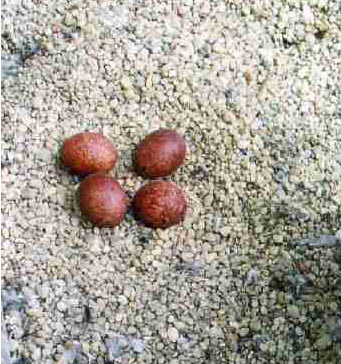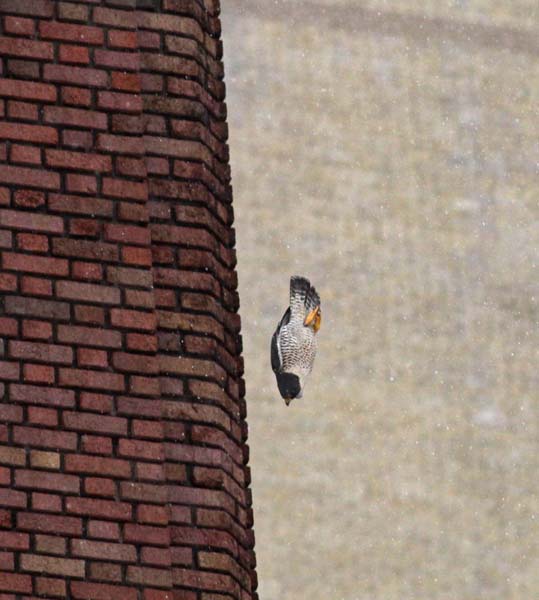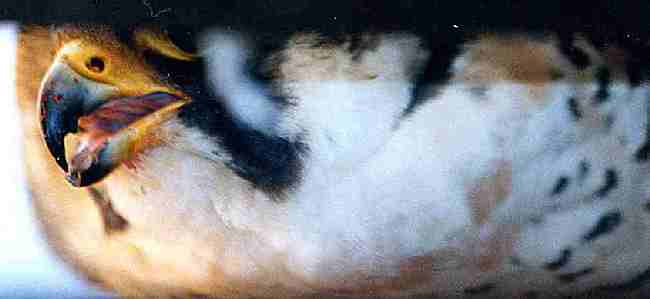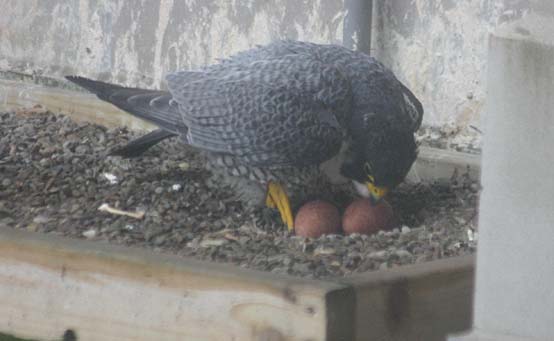FALCON FLASH
Dateline: Cleveland, Ohio
March 16, 2012
The following National Geographic clip shows incredible footage of a peregrine named Frightful as she flies and dives:
Will there be more eggs? Keep your eyes and browser set to:
http://www.falconcam-cmnh.org/news.php Our thanks to the Cleveland Museum of Natural History for sponsoring the FalconCams and for the stills.
Photo of the stoop is courtesy of volunteer nest monitors Mr. and Mrs. Saladin. Other photos are courtesy of volunteer nest monitor Scott Wright. They can be used in any non-commercial publication, electronic or print, but please give photo credit.
Click here to read what happened earlier
After a pause in egg-laying, there are now 4 eggs in the nestbox.
The following 2 pictures captured from the FalconCam show SW as she laid the 4th egg.
SW usually has 4 eggs, and most peregrines have three or four eggs. Some young females may produce less and some females may have five or even seven eggs, but it seems to be difficult for most peregrine parents to keep up with feeding more than 4 hungry growing chicks. Mr. Harvey Webster, Director of Wildlife Resources at the Cleveland Museum of Natural History, tells us, “Now comes the waiting game and guessing on hatch dates. Peregrine Falcon eggs take 31.5 days of active incubation before pipping and anywhere from 24 to 48 hours from pip to hatch. So the average from onset of incubation to hatch is 33 days…. However, active incubation often commences with the appearance of the second egg. It is a tribute to the dedication of both adults that they can incubate the eggs under uncomfortably cold, wet, snowy and windy conditions…..” You can do the math and figure out approximately when the first chick will hatch.
After each egg appears, volunteer nest monitor Mr. Scott Wright, tells us, “The male will smell his new egg to get its scent.... I once saw a male tasting the egg, opening up his beak and gently touching the egg with his tongue!!” This is Boomer greeting a new egg.
Peregrine falcons are fierce predators, and their prey is other birds. One of the main reasons they have moved into cities is because there are so many birds available to hunt year-round. Peregrines dive for their food, a method that allows them to achieve great speed. A straight-down dive with wings folded to the sides is called a "stoop", and speed may reach 200 miles per hour (320 km/h) or more. This is SW in a stoop.
Here is description of a stoop from an eyewitness who works in an office near the nestsite: "Saw the male in a stoop. He went past my office window in an absolute vertical dive at a speed that startled me. It occurred at a moment (split second) that I happened to be glancing out the window at the lake. He missed his intended target, which I never saw, and flew to the top of the Marion Bldg. on West 3rd. Street…….. I can only say that this bird's speed was incredible---like a bullet shot!!! I know their speed is estimated to be approximately 200MPH--but to actually see it is an incredible experience."
Mr. Scott Wright, who has monitored this nestsite for many years, adds: "Actually, the speed is more like 250mph! I had a radar gun lent to me by MPH, (a company in Kentucky that makes radar guns for the police) and I had the gun for two years. I had Szell (an earlier male peregrine falcon at this nestsite) at over 250mph."
The falcon uses its talons to strike and/or grasp the prey in flight, and the impact is usually strong enough to kill the prey instantly. After the prey has been struck (people who have witnessed a strike say it looks like an explosion of feathers) the peregrine must catch the prey as it falls. If the prey is not dead, peregrines will bite the neck of the victim to finish it off, and they have a special notch in their beak for this purpose.
Click here to read what happened next






